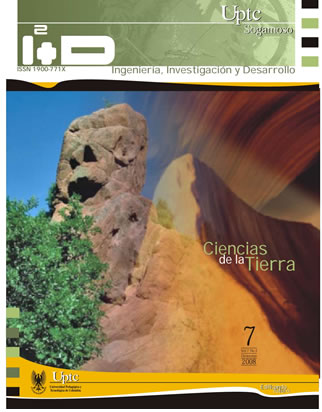The utility of the analysis bio-estratigraphic in correlation of the units lithic-estratigraphic of the eocene-miocene in Urabá, Antioquia

Abstract
From the bioestratigraphic information of the wells: Urabá 1629-IX and Piedrecitas 1570-IX, and the reports published by Ingeominas, the Colombian Mining National Agency it is tested the planktonic foraminipheral utility in the identification of the outcropped units with coal content in the surface, as a hypothesis. The zone's intense tectonic complexity, linked with the lithic wells reports, added the different conditions of sedimentation of the distinc units, partially disfavor this hypotthesis, due that it was found that the tectonic activities punctured the units and changed the deposits enviromental conditions. At the well Piedrecitas 1570-IX, the species recognized (Globigerinoides extreme, G. slanted, G. immature Globoquadrina altispira, Globorotalia menardii, Neogloboquadrina dutertrei y N. pachyderma) that are related with the late miocene units, and can be halpful to recognize the outcropped coal beds.
Keywords
bioestratigraphy, eocene, miocene, Urabá
References
- Agencia nacional de hidrocarburos ANH (2005): Reportes de los pozos urabá1629-IX y Piedrecita 1570-IX, en medio digital (71.8 mb)
- Clavijo, J. y Barrera, R. (2001): Geología de las planchas 44 Sincelejo y 52 Sahagún, Escala 1:100.000, memoria explicativa.
- ingeominas, p. 64, Bogotá.
- Duque Caro, H. (1965). Zonas bioestratigráficas de foramíníferos del Cretácico en Colombia. Informe I-1490, Ingeominas, p. 43, Bogotá.
- Observaciones generales a la bioestratigrafia y geología regional en los departamentos de Bolívar y Córdoba (1968): Informe I-1541, Ingeominas, p. 32, Bogotá.
- Facies sedimentarias del norte de Colombia relacionadas a la paleoecología y a la paleoecología y a la tectónica. Informe I-1550, ingeominas, p. 31. Bogotá.
- On planktonic foraminiferal zonation in the tertiary of Colombia. Informe I-1558, Ingeominas, p. 16, Bogotá.
- Los foramíneros planctónicos y el terciario de Colombia (1973 a): Informe I-1651, Ingeominas , p. 71, Bogotá.
- Características estratigráficas y sedimentarias del terciario marino de Colombia (1973 b): Informe I-1657, Ingeominas, p. 43. Bogotá.
- Geotec Ltda (2003): Geología de los cinturones Sinú San Jacint, memoria explicativa. Ingeominas, p. 225. Bogotá.
- González I., Humberto (2001): Mapa geológico del departamento de Antioquia, memoria explicativa. Ingeominas p. 241, Bogotá.
- Hubach, E. y Gutiérrez, E. (1925): Apuntes sobre la región de Urabá. Informe geográfico geológico Urabá Oriental, Informe 145, Ingeominas, p. 63.
- Mejía U., Luis Jorge, y Franco S. F.(1985): Estudio preliminar de los carbones del área de Urabá - Antioquia. Informe I-1946, Ingeominas, p. 2, Bogotá.
- Mejía, U., Luis Jorge, & Pulido G.Orlando (1999): Mapa de regiones, zonas y subzonas con carbones en Colombia Informe I-2313, Ingeominas, p. 26, Bogotá.
- Nicholis, G. (1999): Sedimentology stratigraphy. Blackwell science Ltda., p. 354, Oxford.
- París G. y Romero, L.J. (1993): Fallas activas en Colombia. Informe I-2177, Ingeominas, p. 42, Cali.